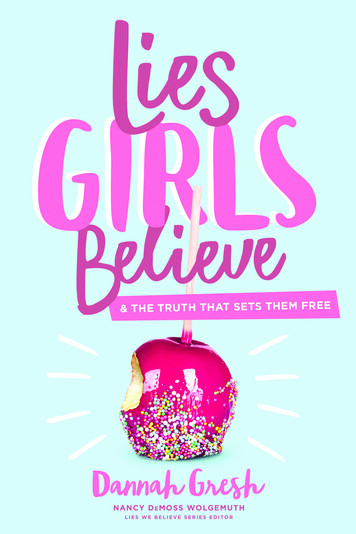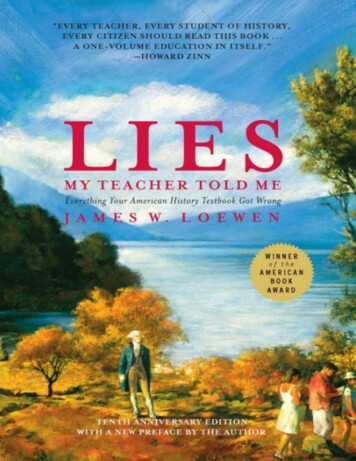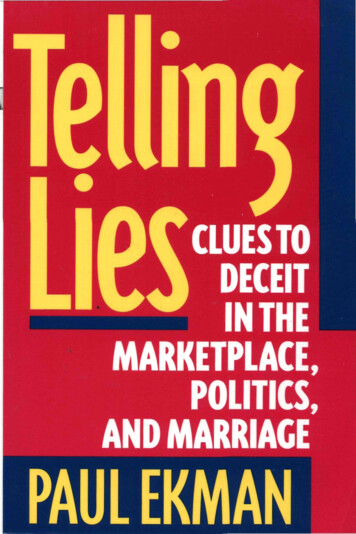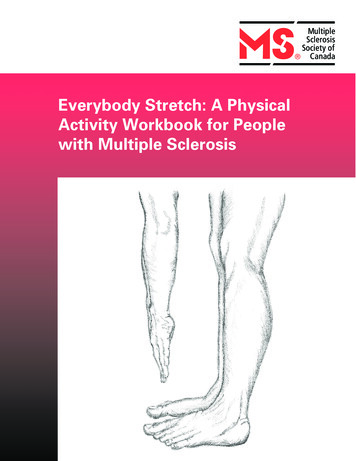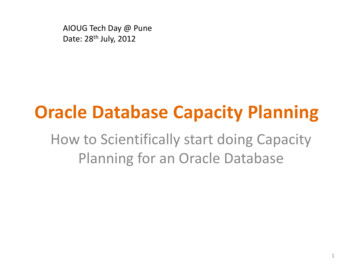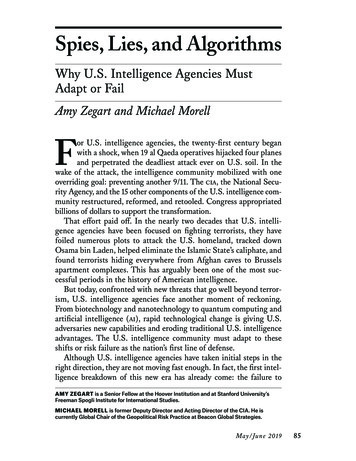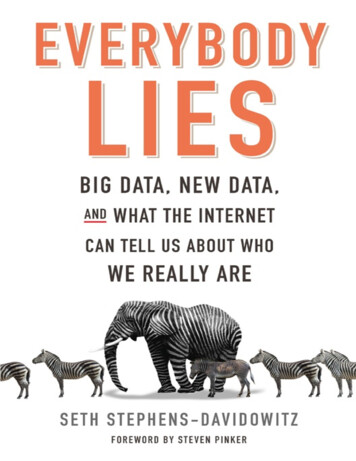
Transcription
DEDICATIONTo Mom and Dad
CONTENTSCoverTitle PageDedicationForeword by Steven PinkerIntroduction: The Outlines of a RevolutionPART I: DATA, BIG AND SMALL1. Your Faulty GutPART II: THE PO WERS O F BIG DATA2. Was Freud Right?3. Data ReimaginedBodies as DataWords as DataPictures as Data4. Digital Truth SerumThe Truth About SexThe Truth About Hate and PrejudiceThe Truth About the InternetThe Truth About Child Abuse and AbortionThe Truth About Your Facebook FriendsThe Truth About Your CustomersCan We Handle the Truth?5. Zooming InWhat’s Really Going On in Our Counties, Cities, and Towns?How We Fill Our Minutes and HoursOur DoppelgangersData Stories6. All the World’s a LabThe ABCs of A/B TestingNature’s Cruel—but Enlightening—ExperimentsPART III: BIG DATA: HANDLE WITH CARE
7. Big Data, Big Schmata? What It Cannot DoThe Curse of DimensionalityThe Overemphasis on What Is Measurable8. Mo Data, Mo Problems? What We Shouldn’t DoThe Danger of Empowered CorporationsThe Danger of Empowered GovernmentsConclusion: How Many People Finish Books?AcknowledgmentsNotesIndexAbout the AuthorCopyrightAbout the Publisher
FOREWORDEver since philosophers speculated about a “cerebroscope,” a mythical device that would display aperson’s thoughts on a screen, social scientists have been looking for tools to expose the workings ofhuman nature. During my career as an experimental psychologist, different ones have gone in and out offashion, and I’ve tried them all—rating scales, reaction times, pupil dilation, functional neuroimaging,even epilepsy patients with implanted electrodes who were happy to while away the hours in a languageexperiment while waiting to have a seizure.Yet none of these methods provides an unobstructed view into the mind. The problem is a savagetradeoff. Human thoughts are complex propositions; unlike Woody Allen speed-reading War and Peace,we don’t just think “It was about some Russians.” But propositions in all their tangled multidimensionalglory are difficult for a scientist to analyze. Sure, when people pour their hearts out, we apprehend therichness of their stream of consciousness, but monologues are not an ideal dataset for testing hypotheses.On the other hand, if we concentrate on measures that are easily quantifiable, like people’s reaction timeto words, or their skin response to pictures, we can do the statistics, but we’ve pureed the complextexture of cognition into a single number. Even the most sophisticated neuroimaging methodologies cantell us how a thought is splayed out in 3-D space, but not what the thought consists of.As if the tradeoff between tractability and richness weren’t bad enough, scientists of human nature arevexed by the Law of Small Numbers—Amos Tversky and Daniel Kahneman’s name for the fallacy ofthinking that the traits of a population will be reflected in any sample, no matter how small. Even the mostnumerate scientists have woefully defective intuitions about how many subjects one really needs in astudy before one can abstract away from the random quirks and bumps and generalize to all Americans, tosay nothing of Homo sapiens. It’s all the iffier when the sample is gathered by convenience, such as byoffering beer money to the sophomores in our courses.This book is about a whole new way of studying the mind. Big Data from internet searches and otheronline responses are not a cerebroscope, but Seth Stephens-Davidowitz shows that they offer anunprecedented peek into people’s psyches. At the privacy of their keyboards, people confess the strangestthings, sometimes (as in dating sites or searches for professional advice) because they have real-lifeconsequences, at other times precisely because they don’t have consequences: people can unburdenthemselves of some wish or fear without a real person reacting in dismay or worse. Either way, thepeople are not just pressing a button or turning a knob, but keying in any of trillions of sequences ofcharacters to spell out their thoughts in all their explosive, combinatorial vastness. Better still, they laydown these digital traces in a form that is easy to aggregate and analyze. They come from all walks of life.They can take part in unobtrusive experiments which vary the stimuli and tabulate the responses in realtime. And they happily supply these data in gargantuan numbers.Everybody Lies is more than a proof of concept. Time and again my preconceptions about my countryand my species were turned upside-down by Stephens-Davidowitz’s discoveries. Where did DonaldTrump’s unexpected support come from? When Ann Landers asked her readers in 1976 whether they
regretted having children and was shocked to find that a majority did, was she misled by anunrepresentative, self-selected sample? Is the internet to blame for that redundantly named crisis of thelate 2010s, the “filter bubble”? What triggers hate crimes? Do people seek jokes to cheer themselves up?And though I like to think that nothing can shock me, I was shocked aplenty by what the internet revealsabout human sexuality—including the discovery that every month a certain number of women search for“humping stuffed animals.” No experiment using reaction time or pupil dilation or functionalneuroimaging could ever have turned up that fact.Everybody will enjoy Everybody Lies. With unflagging curiosity and an endearing wit, StephensDavidowitz points to a new path for social science in the twenty-first century. With this endlesslyfascinating window into human obsessions, who needs a cerebroscope?—Steven Pinker, 2017
INTRODUCTIONTHE OUTLINES OF A REVOLUTIONSurely he would lose, they said.In the 2016 Republican primaries, polling experts concluded that Donald Trump didn’t stand a chance.After all, Trump had insulted a variety of minority groups. The polls and their interpreters told us fewAmericans approved of such outrages.Most polling experts at the time thought that Trump would lose in the general election. Too many likelyvoters said they were put off by his manner and views.But there were actually some clues that Trump might actually win both the primaries and the generalelection—on the internet.I am an internet data expert. Every day, I track the digital trails that people leave as they make their wayacross the web. From the buttons or keys we click or tap, I try to understand what we really want, whatwe will really do, and who we really are. Let me explain how I got started on this unusual path.The story begins—and this seems like ages ago—with the 2008 presidential election and a longdebated question in social science: How significant is racial prejudice in America?Barack Obama was running as the first African-American presidential nominee of a major party. Hewon—rather easily. And the polls suggested that race was not a factor in how Americans voted. Gallup,for example, conducted numerous polls before and after Obama’s first election. Their conclusion?American voters largely did not care that Barack Obama was black. Shortly after the election, two wellknown professors at the University of California, Berkeley pored through other survey-based data, usingmore sophisticated data-mining techniques. They reached a similar conclusion.And so, during Obama’s presidency, this became the conventional wisdom in many parts of the mediaand in large swaths of the academy. The sources that the media and social scientists have used for eightyplus years to understand the world told us that the overwhelming majority of Americans did not care thatObama was black when judging whether he should be their president.This country, long soiled by slavery and Jim Crow laws, seemed finally to have stopped judgingpeople by the color of their skin. This seemed to suggest that racism was on its last legs in America. Infact, some pundits even declared that we lived in a post-racial society.In 2012, I was a graduate student in economics, lost in life, burnt-out in my field, and confident, evencocky, that I had a pretty good understanding of how the world worked, of what people thought and caredabout in the twenty-first century. And when it came to this issue of prejudice, I allowed myself to believe,
based on everything I had read in psychology and political science, that explicit racism was limited to asmall percentage of Americans—the majority of them conservative Republicans, most of them living inthe deep South.Then, I found Google Trends.Google Trends, a tool that was released with little fanfare in 2009, tells users how frequently any wordor phrase has been searched in different locations at different times. It was advertised as a fun tool—perhaps enabling friends to discuss which celebrity was most popular or what fashion was suddenly hot.The earliest versions included a playful admonishment that people “wouldn’t want to write your PhDdissertation” with the data, which immediately motivated me to write my dissertation with it.*At the time, Google search data didn’t seem to be a proper source of information for “serious”academic research. Unlike surveys, Google search data wasn’t created as a way to help us understand thehuman psyche. Google was invented so that people could learn about the world, not so researchers couldlearn about people. But it turns out the trails we leave as we seek knowledge on the internet aretremendously revealing.In other words, people’s search for information is, in itself, information. When and where they searchfor facts, quotes, jokes, places, persons, things, or help, it turns out, can tell us a lot more about what theyreally think, really desire, really fear, and really do than anyone might have guessed. This is especiallytrue since people sometimes don’t so much query Google as confide in it: “I hate my boss.” “I am drunk.”“My dad hit me.”The everyday act of typing a word or phrase into a compact, rectangular white box leaves a small traceof truth that, when multiplied by millions, eventually reveals profound realities. The first word I typed inGoogle Trends was “God.” I learned that the states that make the most Google searches mentioning “God”were Alabama, Mississippi, and Arkansas—the Bible Belt. And those searches are most frequently onSundays. None of which was surprising, but it was intriguing that search data could reveal such a clearpattern. I tried “Knicks,” which it turns out is Googled most in New York City. Another no-brainer. Then Ityped in my name. “We’re sorry,” Google Trends informed me. “There is not enough search volume” toshow these results. Google Trends, I learned, will provide data only when lots of people make the samesearch.But the power of Google searches is not that they can tell us that God is popular down South, theKnicks are popular in New York City, or that I’m not popular anywhere. Any survey could tell you that.The power in Google data is that people tell the giant search engine things they might not tell anyone else.Take, for example, sex (a subject I will investigate in much greater detail later in this book). Surveyscannot be trusted to tell us the truth about our sex lives. I analyzed data from the General Social Survey,which is considered one of the most influential and authoritative sources for information on Americans’behaviors. According to that survey, when it comes to heterosexual sex, women say they have sex, onaverage, fifty-five times per year, using a condom 16 percent of the time. This adds up to about 1.1 billioncondoms used per year. But heterosexual men say they use 1.6 billion condoms every year. Thosenumbers, by definition, would have to be the same. So who is telling the truth, men or women?Neither, it turns out. According to Nielsen, the global information and measurement company that tracksconsumer behavior, fewer than 600 million condoms are sold every year. So everyone is lying; the onlydifference is by how much.
The lying is in fact widespread. Men who have never been married claim to use on average twentynine condoms per year. This would add up to more than the total number of condoms sold in the UnitedStates to married and single people combined. Married people probably exaggerate how much sex theyhave, too. On average, married men under sixty-five tell surveys they have sex once a week. Only 1percent say they have gone the past year without sex. Married women report having a little less sex butnot much less.Google searches give a far less lively—and, I argue, far more accurate—picture of sex duringmarriage. On Google, the top complaint about a marriage is not having sex. Searches for “sexlessmarriage” are three and a half times more common than “unhappy marriage” and eight times morecommon than “loveless marriage.” Even unmarried couples complain somewhat frequently about nothaving sex. Google searches for “sexless relationship” are second only to searches for “abusiverelationship.” (This data, I should emphasize, is all presented anonymously. Google, of course, does notreport data about any particular individual’s searches.)And Google searches presented a picture of America that was strikingly different from that post-racialutopia sketched out by the surveys. I remember when I first typed “nigger” into Google Trends. Call menaïve. But given how toxic the word is, I fully expected this to be a low-volume search. Boy, was Iwrong. In the United States, the word “nigger”—or its plural, “niggers”—was included in roughly thesame number of searches as the word “migraine(s),” “economist,” and “Lakers.” I wondered if searchesfor rap lyrics were skewing the results? Nope. The word used in rap songs is almost always “nigga(s).”So what was the motivation of Americans searching for “nigger”? Frequently, they were looking for jokesmocking African-Americans. In fact, 20 percent of searches with the word “nigger” also included theword “jokes.” Other common searches included “stupid niggers” and “I hate niggers.”There were millions of these searches every year. A large number of Americans were, in the privacy oftheir own homes, making shockingly racist inquiries. The more I researched, the more disturbing theinformation got.On Obama’s first election night, when most of the commentary focused on praise of Obama andacknowledgment of the historic nature of his election, roughly one in every hundred Google searches thatincluded the word “Obama” also included “kkk” or “nigger(s).” Maybe that doesn’t sound so high, butthink of the thousands of nonracist reasons to Google this young outsider with a charming family about totake over the world’s most powerful job. On election night, searches and sign-ups for Stormfront, a whitenationalist site with surprisingly high popularity in the United States, were more than ten times higher thannormal. In some states, there were more searches for “nigger president” than “first black president.”There was a darkness and hatred that was hidden from the traditional sources but was quite apparent inthe searches that people made.Those searches are hard to reconcile with a society in which racism is a small factor. In 2012 I knew ofDonald J. Trump mostly as a businessman and reality show performer. I had no more idea than anyoneelse that he would, four years later, be a serious presidential candidate. But those ugly searches are nothard to reconcile with the success of a candidate who—in his attacks on immigrants, in his angers andresentments—often played to people’s worst inclinations.The Google searches also told us that much of what we thought about the location of racism was wrong.
Surveys and conventional wisdom placed modern racism predominantly in the South and mostly amongRepublicans. But the places with the highest racist search rates included upstate New York, westernPennsylvania, eastern Ohio, industrial Michigan and rural Illinois, along with West Virginia, southernLouisiana, and Mississippi. The true divide, Google search data suggested, was not South versus North; itwas East versus West. You don’t get this sort of thing much west of the Mississippi. And racism was notlimited to Republicans. In fact, racist searches were no higher in places with a high percentage ofRepublicans than in places with a high percentage of Democrats. Google searches, in other words, helpeddraw a new map of racism in the United States—and this map looked very different from what you mayhave guessed. Republicans in the South may be more likely to admit to racism. But plenty of Democrats inthe North have similar attitudes.Four years later, this map would prove quite significant in explaining the political success of Trump.In 2012, I was using this map of racism I had developed using Google searches to reevaluate exactlythe role that Obama’s race played. The data was clear. In parts of the country with a high number of racistsearches, Obama did substantially worse than John Kerry, the white Democratic presidential candidate,had four years earlier. The relationship was not explained by any other factor about these areas, includingeducation levels, age, church attendance, or gun ownership. Racist searches did not predict poorperformance for any other Democratic candidate. Only for Obama.And the results implied a large effect. Obama lost roughly 4 percentage points nationwide just fromexplicit racism. This was far higher than might have been expected based on any surveys. Barack Obama,of course, was elected and reelected president, helped by some very favorable conditions for Democrats,but he had to overcome quite a bit more than anyone who was relying on traditional data sources—andthat was just about everyone—had realized. There were enough racists to help win a primary or tip ageneral election in a year not so favorable to Democrats.My study was initially rejected by five academic journals. Many of the peer reviewers, if you willforgive a little disgruntlement, said that it was impossible to believe that so many Americans harboredsuch vicious racism. This simply did not fit what people had been saying. Besides, Google searchesseemed like such a bizarre dataset.Now that we have witnessed the inauguration of President Donald J. Trump, my finding seems moreplausible.The more I have studied, the more I have learned that Google has lots of information that is missed by thepolls that can be helpful in understanding—among many, many other subjects—an election.There is information on who will actually turn out to vote. More than half of citizens who don’t votetell surveys immediately before an election that they intend to, skewing our estimation of turnout, whereasGoogle searches for “how to vote” or “where to vote” weeks before an election can accurately predictwhich parts of the country are going to have a big showing at the polls.There might even be information on who they will vote for. Can we really predict which candidatepeople will vote for just based on what they search? Clearly, we can’t just study which candidates aresearched for most frequently. Many people search for a candidate because they love him. A similarnumber of people search for a candidate because they hate him. That said, Stuart Gabriel, a professor offinance at the University of California, Los Angeles, and I have found a surprising clue about which way
people are planning to vote. A large percentage of election-related searches contain queries with bothcandidates’ names. During the 2016 election between Trump and Hillary Clinton, some people searchedfor “Trump Clinton polls.” Others looked for highlights from the “Clinton Trump debate.” In fact, 12percent of search queries with “Trump” also included the word “Clinton.” More than one-quarter ofsearch queries with “Clinton” also included the word “Trump.”We have found that these seemingly neutral searches may actually give us some clues to whichcandidate a person supports.How? The order in which the candidates appear. Our research suggests that a person is significantlymore likely to put the candidate they support first in a search that includes both candidates’ names.In the previous three elections, the candidate who appeared first in more searches received the mostvotes. More interesting, the order the candidates were searched was predictive of which way a particularstate would go.The order in which candidates are searched also seems to contain information that the polls can miss.In the 2012 election between Obama and Republican Mitt Romney, Nate Silver, the virtuoso statisticianand journalist, accurately predicted the result in all fifty states. However, we found that in states thatlisted Romney before Obama in searches most frequently, Romney actually did better than Silver hadpredicted. In states that most frequently listed Obama before Romney, Obama did better than Silver hadpredicted.This indicator could contain information that polls miss because voters are either lying to themselvesor uncomfortable revealing their true preferences to pollsters. Perhaps if they claimed that they wereundecided in 2012, but were consistently searching for “Romney Obama polls,” “Romney Obamadebate,” and “Romney Obama election,” they were planning to vote for Romney all along.So did Google predict Trump? Well, we still have a lot of work to do—and I’ll have to be joined bylots more researchers—before we know how best to use Google data to predict election results. This is anew science, and we only have a few elections for which this data exists. I am certainly not saying we areat the point—or ever will be at the point—where we can throw out public opinion polls completely as atool for helping us predict elections.But there were definitely portents, at many points, on the internet that Trump might do better than thepolls were predicting.During the general election, there were clues that the electorate might be a favorable one for Trump.Black Americans told polls they would turn out in large numbers to oppose Trump. But Google searchesfor information on voting in heavily black areas were way down. On election day, Clinton would be hurtby low black turnout.There were even signs that supposedly undecided voters were going Trump’s way. Gabriel and I foundthat there were more searches for “Trump Clinton” than “Clinton Trump” in key states in the Midwest thatClinton was expected to win. Indeed, Trump owed his election to the fact that he sharply outperformed hispolls there.But the major clue, I would argue, that Trump might prove a successful candidate—in the primaries, tobegin with—was all that secret racism that my Obama study had uncovered. The Google searchesrevealed a darkness and hatred among a meaningful number of Americans that pundits, for many years,missed. Search data revealed that we lived in a very different society from the one academics and
journalists, relying on polls, thought that we lived in. It revealed a nasty, scary, and widespread rage thatwas waiting for a candidate to give voice to it.People frequently lie—to themselves and to others. In 2008, Americans told surveys that they no longercared about race. Eight years later, they elected as president Donald J. Trump, a man who retweeted afalse claim that black people are responsible for the majority of murders of white Americans, defendedhis supporters for roughing up a Black Lives Matters protester at one of his rallies, and hesitated inrepudiating support from a former leader of the Ku Klux Klan. The same hidden racism that hurt BarackObama helped Donald Trump.Early in the primaries, Nate Silver famously claimed that there was virtually no chance that Trumpwould win. As the primaries progressed and it became increasingly clear that Trump had widespreadsupport, Silver decided to look at the data to see if he could understand what was going on. How couldTrump possibly be doing so well?Silver noticed that the areas where Trump performed best made for an odd map. Trump performed wellin parts of the Northeast and industrial Midwest, as well as the South. He performed notably worse outWest. Silver looked for variables to try to explain this map. Was it unemployment? Was it religion? Was itgun ownership? Was it rates of immigration? Was it opposition to Obama?Silver found that the single factor that best correlated with Donald Trump’s support in the Republicanprimaries was that measure I had discovered four years earlier. Areas that supported Trump in the largestnumbers were those that made the most Google searches for “nigger.”
I have spent just about every day of the past four years analyzing Google data. This included a stint as adata scientist at Google, which hired me after learning about my racism research. And I continue toexplore this data as an opinion writer and data journalist for the New York Times. The revelations havekept coming. Mental illness; human sexuality; child abuse; abortion; advertising; religion; health. Notexactly small topics, and this dataset, which didn’t exist a couple of decades ago, offered surprising newperspectives on all of them. Economists and other social scientists are always hunting for new sources ofdata, so let me be blunt: I am now convinced that Google searches are the most important dataset evercollected on the human psyche.This dataset, however, is not the only tool the internet has delivered for understanding our world. Isoon realized there are other digital gold mines as well. I downloaded all of Wikipedia, pored throughFacebook profiles, and scraped Stormfront. In addition, PornHub, one of the largest pornographic sites onthe internet, gave me its complete data on the searches and video views of anonymous people around theworld. In other words, I have taken a very deep dive into what is now called Big Data. Further, I haveinterviewed dozens of others—academics, data journalists, and entrepreneurs—who are also exploringthese new realms. Many of their studies will be discussed here.But first, a confession: I am not going to give a precise definition of what Big Data is. Why? Becauseit’s an inherently vague concept. How big is big? Are 18,462 observations Small Data and 18,463observations Big Data? I prefer to take an inclusive view of what qualifies: while most of the data I
fiddle with is from the internet, I will discuss other sources, too. We are living through an explosion in theamount and quality of all kinds of available information. Much of the new information flows from Googleand social media. Some of it is a product of digitization of information that was previously hidden awayin cabinets and files. Some of it is from increased resources devoted to market research. Some of thestudies discussed in this book don’t use huge datasets at all but instead just employ a new and creativeapproach to data—approaches that are crucial in an era overflowing with information.So why exactly is Big Data so powerful? Think of all the information that is scattered online on a givenday—we have a number, in fact, for just how much information there is. On an average day in the earlypart of the twenty-first century, human beings generate 2.5 million trillion bytes of data.And these bytes are clues.A woman is bored on a Thursday afternoon. She Googles for some more “funny clean jokes.” Shechecks her email. She signs on to Twitter. She Googles “nigger jokes.”A man is feeling blue. He Googles for “depression symptoms” and “depression stories.” He plays agame of solitaire.A woman sees the announcement of her friend getting engaged on Facebook. The woman, who issingle, blocks the friend.A man takes a break from Googling about the NFL and rap music to ask the search engine aquestion: “Is it normal to have dreams about kissing men?”A woman clicks on a BuzzFeed story showing the “15 cutest cats.”A man sees the same story about cats. But on his screen it is called “15 most adorable cats.” Hedoesn’t click.A woman Googles “Is my son a genius?”A man Googles “how to get my daughter to lose weight.”A woman is on a vacation with her six best female friends. All her friends keep saying how much funthey’re having. She sneaks off to Google “loneliness when away from husband.”A man, the previous woman’s husband, is on a vacation with his six best male friends. He sneaks offto Google to type “signs your wife is cheating.”Some of this data will include information that would otherwise never be admitted to anybody. If weaggregate it all, keep it anonymous to make sure we never know about the fears, desires, and behaviors ofany specific individuals, and add some data science, we start to get a new look at human beings—theirbehaviors, their desires, their natures. In fact, at the risk of sounding grandiose, I have come to believethat the new data increasingly available in our digital age will radically expand our understanding ofhumankind. The microscope showed us there is more to a drop of pond water than we think we see. Thetelescope showed us there is more to the night sky than we think we see. And new, digital data now showsus there is more to human society than we think we see. It may be our era’s microscope or telescope—making possible important, even revolutionary insights.There is another risk in making such declarations—not just sounding grandiose but also trendy. Manypeople have been making big claims about the power of Big Data. But they have been short on evidence.This has inspired Big Data skeptics, of whom there are also many, to dismiss the search for biggerdatasets. “I am not saying here that there is no information in Big Data,” essayist and statistician NassimTaleb has written. “There is plenty of information. The problem—the central issue—is that the needle
comes in an increasingly larger haystack.”One of the primary goals of this book, then, is to provide the missing evidence of what can be donewith Big Data—how we can find the needles, if you will, in those larger and larger haystacks. I hope toprovide enough examples of Big Data offering new insights into human psychology and behavior so thatyou will begin to see the outlines of something truly revolutionary.“Hold on, Seth,” you might be say
This book is about a whole new way of studying the mind. Big Data from internet searches and other . Everybody will enjoy Everybody Lies. With unflagging curiosity and an endearing wit, Stephen
